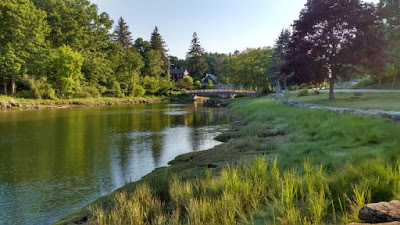Intriguing Cause of Death: Tabes Dorsalis
Warren J Dane: 1839-1907
Warren J.
Dane, also called J. Warren Dane, is my first cousin four times removed. While
the relationship is distant, when I discover something of historical interest
in distant ancestors’ lives, I like to record and share it so that we can
better understand the time period in which they lived. Warren Dane is
illustrative: his cause of death is one that is rarely seen any more, for good
reason.
Warren was
born in 1839 in Derby, Orleans County, Vermont, to parents Joseph Dane and Jane
Wheeler Dane. Joseph Dane was the sibling of my fourth great-grandfather David
Dane. Warren, like his father and at least one brother, became a carpenter.
Warren
enlisted in the cavalry during the Civil War; he was 22 years old. He served as
a private in the Vermont First Regiment Cavalry, Company I. The volunteer
regiment fought in 76 engagements during the war, including the Shenandoah
Valley Campaign, Gettysburg, and the Wilderness Campaign. According to his war
record, Warren was captured by Confederate troops on October 24, 1862. He was a
prisoner of war for slightly less than a week; he was paroled by the
Confederates on October 30, 1862. This was a period when the regiment was
protecting Washington, D.C. from attack.
Warren
returned to duty after his release, and served two more years in the cavalry,
mustering out on December 31, 1864. He then returned to his home area, living
in Newport, Vermont, also in Orleans County. There is very little information about
the remainder of his life.
Warren died
June 20, 1907 at age 68, after being hospitalized in the Vermont Soldiers Home.
His cause of death was unusual and required research: tabes dorsalis.
According
to Medlineplus.com,
“Tabes dorsalis is a form of neurosyphilis,
which is a complication of late stage syphilis infection. Syphilis is a
bacterial infection that is spread sexually.
When syphilis is untreated, the
bacteria damages the spinal cord and peripheral nervous tissue. This leads to
the symptoms of tabes dorsalis.
Tabes dorsalis is now very rare
because syphilis is usually treated early in the disease.”
An online medical dictionary provided the grim symptoms:
“A late form of syphilis resulting
in a hardening of the dorsal columns of the spinal cord and marked by shooting
pains, emaciation, loss of muscular coordination, and disturbances of sensation
and digestion.”
Damage to
the optic nerve, leading to blindness, is another symptom. Apparently it takes
at least twenty years for syphilis to progress to such a state, so Warren had
been infected many years earlier.
Warren
never married, although obviously he had a relationship with at least one woman
in his life. Did he frequent prostitutes? Did he contract the disease as far
back as during his Civil War service? Did he choose not to marry because he
knew he was infected and didn’t want to infect a spouse? We will never know.
The cure
for syphilis was found in 1910, just three years after Warren’s death. His
death is a reminder of how dangerous sexually transmitted diseases were in the
19th century. Thank goodness this terrible condition is rarely seen
in the 21st century.
Sources:
https://medlineplus.gov/ency/article/000729.htm
https://www.medicinenet.com/tabes_dorsalis/definition.htm







